#Isidoro Gomez
Text
"El tipo puede cambiar de todo, de cara, de casa, de familia, de novia, de religión, de Dios... pero, hay una cosa que no puede cambiar(...) No puede cambiar de Pasión".
— Pablo Sandoval. "El secreto de sus ojos".
#ricardo darín#Benjamin Esposito#racing#pablo sandoval#guillermo francella#el secreto de sus ojos#Isidoro Gomez#Javier Godino#Fútbol#Cancha.
30 notes
·
View notes
Text

Bienvenidos a un torneo mal hecho, poco serio, casi inentendible que incluye: una enorme cantidad de personajes de procedencia dudosa, muchisimas encuestas y una final que va a incluir 3 personajes porque SOY TAN MALO EN MATEMÁTICAS QUE NO CALCULE NADA
AH Y SORPRESA! Metí algunos personajes más creyendo que resolvería el error matemático (no lo hizo)
anyways comenzamos con la primera ronda: Iré colocando acá bajo los links de las encuestas (si me acuerdo JAJSJSJS)
EDIT: Gustavo Fring reemplaza a Namor
Yaolt es reemplazado por Aldeberan de Caballeros del Zodiaco
Primera Ronda
Guillermo de la Cruz vs Coco
Lucas Amato vs El Profesor Jirafales
Dr Flug vs El Mandalorian
Carlos vs Panchito Pistoles
Tulio Triviño vs El Chapulín Colorado
El canario de la película de Rio (2011) vs Rodolfo Rivera
Goku vs El condorito
Lobo/La muerte vs Joaquín
José Carioca vs Isidoro Cañones
Lúcio vs Bruno
Carlitox vs Juandisimo
Lalo vs Compayito
Julio vs Kronk
El papa de Mafalda vs Ravenna
Adrián Seidelman vs Colgate 360
Roberto da Costa vs Don Ramón
Don Armando vs Pacha
Homero/Gomez Addams vs Juan Carlos Bodoque
Héctor vs Mr Trance
Black Hat vs Gabriel Reyes
Locutor/The Host vs Manolo
Guillermo de la Cruz vs Coco
Lucas Amato vs El Profesor Jirafales
Carlos vs Panchito Pistoles
Tulio Triviño vs El Chapulín Colorado
El canario de la película de Rio (2011) vs Rodolfo Rivera
Goku vs El condorito
Lobo/La muerte vs Joaquín
José Carioca vs Isidoro Cañones
Lúcio vs Bruno
Carlitox vs Juandisimo
Lalo vs Compayito
Julio vs Kronk
El papa de Mafalda vs Ravenna
Adrián Seidelman vs Colgate 360
Roberto da Costa vs Don Ramón
Don Armando vs Pacha
Homero/Gomez Addams vs Juan Carlos Bodoque
Héctor vs Mr Trance
Black Hat vs Gabriel Reyes
Locutor/The Host vs Manolo
Gus vs Adelbarán
Doctor Simi vs Santos
Yasutora Sado/Chad vs Albertano
784 notes
·
View notes
Photo
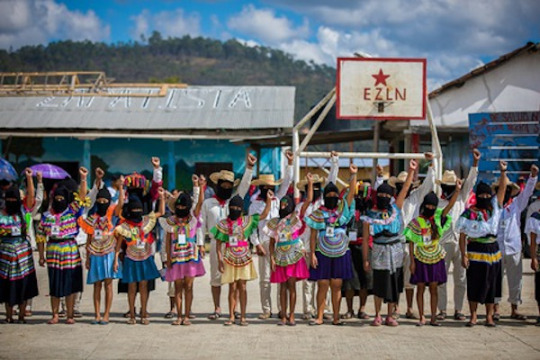
#HailCaesar #BirtherInChief #CorpMedia #Idiocracy #Oligarchs #MegaBanks vs #Union #Occupy #NoDAPL #BLM #SDF #DACA #MeToo #Humanity #DemExit
#WriteInBernie
Stop the aggressions against the Zapatistas! - Manifesto signed by Noam Chomsky, Boaventura De Sousa, Raúl Zibechi, Enzo Traverso, Gilberto López y Rivas and more.
Today those who defend the environment are slaughtered every day. At a time like the one that the planet lives in which the protection of those who defend it is required, the opposite happens. Those who have resisted this destruction by the powerful have not stopped saying NO, they have always done so, although the current administration does not want to have memory.
The murder in the community of Amilcingo, Morelos of Samir Flores, a member of the resistance against the Comprehensive Plan Morelos, its gas pipeline and thermoelectric plants that put the life and territory of Nahua communities in Puebla and Morelos at risk; the massacre of 15 Ikoot indigenous people in San Mateo del Mar, Oaxaca, one of the regions that has opposed the Trans-isthmian Corridor projects; the growing paramilitary violence in Chiapas, with 56 attacks in the municipality of Aldama alone, and the kidnapping in February of members of the National Indigenous Council (CNI) of the municipality of Chenalhó are proof that the war continues.
Now the violence is becoming more and more explicit against the Zapatista communities. The growth of the activity of paramilitary groups such as “Los Chinchulines” or the Regional Organization of Coffee Growers of Ocosingo (ORCAO), as well as the appearance of new groups, is exacerbating tension in the region. The theft and burning of warehouses and houses of the Moisés Ghandi community, of the Autonomous Rebel Zapatista Municipality “Lucio Cabañas”, (in the official municipality of Ocosingo), show the increase in the intensity of the aggressions and provocations against the Zapatista Army of National Liberation. The EZLN has respected the ceasefire for years and has focused on strengthening its autonomous organizational processes with schools, clinics, and justice systems. It is serious that one of the ethical references of resistance and construction of concrete and viable alternatives for the planet continues to be under siege, and it is even more serious that the response of those who seek to “transform Mexico” is complicity or oblivion in the face of these extermination attempts. .
It is extremely worrying that this occurs in the context of the Covid-19 pandemic, that there are those who seek to take advantage of the vulnerability in which everyone finds themselves to fuel their ambitions for money and power. It is more worrisome when those who are supposedly in charge of preventing such abuses allow and therefore favor them.
Beyond the erroneous or successful changes of the executive power, which shows this escalation of violence in indigenous areas, and the worsening of paramilitary attacks in the Zapatista territory in Chiapas, is the continuity of the racist, colonial and paternalistic vision of the governments. liberals and conservatives, left and right. Projects such as the Mayan Train show the idea of bringing "development" to indigenous peoples by turning them into cheap labor and contributing only the folkloric image of the Mexican indigenous.
The violence and dispossession of indigenous territories that megaprojects such as the Trans-isthmian Corridor or the Mayan Train imply and require are the ethical breaking point of the current Mexican government, it is where the moral stature that President López Obrador has awarded in front of its predecessors begins to collapse.
Those of us who signed this letter are watching carefully what is happening in Mexico, what is happening in the Zapatista communities that for decades have been a benchmark for other ways of living, health, education, justice, politics. We will not allow the extermination of indigenous peoples with the recurring excuse of development.
International firms
Noam Chomsky (USA)
Saskia Sassen (USA)
Raúl Zibechi (Uruguay)
Marcos Roitman (Spanish State)
Oscar Olivera (Bolivia)
Hugo Blanco Galdos (Peru)
Boaventura De Sousa Santos (Portugal)
Michael Hardt (USA)
Yvon Le Bot (France)
Philippe Corcuff (France)
Jaime Pastor (Spanish State)
Manuel Garí Ramos. Economist. Member of Anticapitalistas (Spanish State)
Juan Wahren (Argentina)
Sabrina Melenotte (France)
Daniel Mato (Argentina)
John Gibler (USA)
José Angel Quintero Weir - Wainjirawa Indigenous Organization (Venezuela)
Roberto Ojeda Escalante (Cusco, Peru)
Pepe Mejía, journalist, social activist, Correspondent for Indigenous Struggle in Europe
Pierluigi Sullo (Italy)
Enzo Traverso (Italy)
Derly Constanza Cuetia Dagua (Nasa People, Colombia)
Vilma Rocío Almendra (Colombia)
Manuel Rozental (Colombia)
Raúl Camargo. Former deputy of Madrid. Spokesperson for Anticapitalistas (Spanish State)
Genaro Raboso Saelices. Unionist of Workers' Commissions (Spanish State)
Ana María Gordaliza Fernández. Psychoanalyst. (Spanish state)
Ana Barba. Pharmaceutical (Spanish State)
Marià Delás Briefcase. Journalist (Spanish State)
Lurdes Lucia. Editor Feminist. (Spanish state)
José Vicente Barcia. Ecologist (Spanish State)
Rocío Van Der Heide García. Anti-capitalists. Social worker (Spanish State)
Patri Amaya. Feminist. LGTBI Movement (Spanish State)
Fernando Cabrerizo. Multimedia Technician (Spanish State)
Pablo Pérez Garfonina. Member of Adelante Andalucía (Spanish State)
Ramon Gorriz Vitalla, union member of Workers' Commissions (Spanish State)
Roberto Montoya Batiz. Journalist (Spanish State)
Laura Lucía Pérez Ruano. Jurist. Teacher. Former deputy of Navarra (Spanish State)
Carmen San José Pérez. Family doctor. Unionist of the Assembly Movement of Health Workers (MATS) (Spanish State)
Juan Hernández Zubizarreta. College professor. Member of the Observatory of Multinationals of Latin America. (Spanish state)
Lorena Garrón Rincón. Councilor of the Cádiz City Council. (Spanish state)
Alicia López Hernando. Feminist Movement (Spanish State)
Ángela Aguilera Clavijo, deputy spokesperson of the Adelante Andalucía group in the Andalusian Parliament (Spanish State)
Demetrio Quirós. Councilor of the Cádiz City Council (Spanish State)
Jorge Riechmann Fernández. Professor at the Autonomous University of
Madrid and writer (Spanish State)
Mónica Rocha Medina, Bolivian Center for Popular Studies (Bolivia)
Huáscar Salazar Lohman, Bolivian Center for Popular Studies (Bolivia)
Patrick Silberstein (France)
Tomas Astelarra, journalist (Argentina)
Mexican firms
Paul Hersch Martinez
Alicia Castellanos Guerrero, UAM-I
Gilberto López y Rivas, INAH- Morelos
Juan Carlos Rulfo. Filmmaker. Mexico City.
Margara Millán, professor, UNAM
Fernanda Navarro
Paul Leduc
Magdalena Gomez
Francisco Barrios "El Cress"
Eduardo Almeida Acosta
Maria Eugenia Sánchez Díaz de Rivera
Graciela Mijares López
Alexander Varas
Volga De Pina, defender of Human Rights.
Marta De Cea. Cultural Promoter. Mexico
Mariana Mora, CIESAS CDMX and Red de Feminismos Descoloniales
Bruno Baronnet, Universidad Veracruzana
Isidoro Moreno. Emeritus Professor of Anthropology. Sevilla University. Andalusia
Francisco Morfin Otero. Instituto Superior Intercultural Ayuuk ISIA
Kathia Núñez Patiño Faculty of Social Sciences C-III. A CH
Richard Stahler-Sholk Eastern Michigan University, USA
Jean Robert Architect, Professor at La Salle University
Sylvia Marcos, Network of decolonial Feminisms, Professor at the Ibero-American University
Servando Gaja, Cinematographer
Inés Durán Matute, sociologist.
Mariana favela
Barbara Zamora
Susana Vázquez Vidal, PhD at CIESAS Occidente.
Orb Larisa
Antonio Sarmiento
Hector Zetina
Raúl Romero, sociologist, Mexico.
Raúl Gutiérrez Narváez, Intercultural Inductive Education Network and CIESAS, Chiapas
Sergio Tischler
Fernando Matamoros Ponce, Research Professor, Postgraduate in Sociology (ICSyH-BUAP)
Joaquín Osorio G. ITESO
Rubén Martin, freelance journalist, Guadalajara
Lucia Linsalata
Ana Maria Vera
Isis Samaniego-Poet
Bertha Melendez «Yuhcatla»
Maria Luisa Arroyo Rodriguez
Epifanio Flores and Manzola
Amparo Seville
J. Jesus Maria Serna Moreno
Sergio Hernández / Uci, Zautla, Puebla
Paulino Alvarado
Erika Sánchez Cruz, professor at BUAP
Irma Zentle Colotl, Social Economist
Wullfrano Ramírez, Dr. Artificial Intelligence
Mirna Valdés, Poet
Horacio Torres de Ita
Alejandra Jiménez, Rural Teacher
Ana Melissa Valenzuela, Educator
Zitlalli López Mendoza, Educator
Cristian Añorve, Student
Roxana Bolio
Jose Meza Rosas
Luis Saracho de María y Campos
Florina Mendoza Jimenez
Leonel Lopez
María de Lourdes Mejía, Mother of Carlos Sinuhé Cuevas Mejía
Angel Benhumea Salazar
Roberto Rodríguez Contreras "Cat"
Isabel Maldonado Hernandez
Omar Abrego Torres
Alfredo Velarde Saracho, professor at the Faculty of Economics
Ana Laura Suarez Lima
Azael Soriano Sanchez
Cecilia Zeledon
Diana Patricia González Ferreira, ICSYH Sociology Teacher
Organizations
Colectivo La Resistencia (Los Angeles, USA)
Solidarity with the Mexican people - Málaga (Spanish State)
Union Communiste libertaire (Marseille, France)
Union syndicale Solidaires, (France)
Vocesenlucha - Popular Communication (Spanish State)
Collectif Paris-Ayotzinapa (France)
Towns in Camino (Colombia)
Éditions Syllepse (France)
Network of Brotherhood and Solidarity with Colombia (Colombia)
International Commission of the People's Congress (Colombia)
Network Against Repression and for Solidarity (RvsR)
Human Rights Node (NODHO)
Errant Etcetera
Labor and Socialist Unity (UníoS!)
Union of Neighbors and Victims "September 19" (UVyd-19)
Community Communication Research Center A.C. (CICC A.C.)
Popular Indigenous Council of Oaxaca Ricardo Flores Magón (CIPO-RFM)
Indigenous and Popular Council of Guerrero - Emiliano Zapata (CIPOG-EZ)
Guardians and Guardians of the Metlapanapa River
Otomí Indigenous Community residing in CDMX
Support network for the CNI-CIG Ibero Puebla
Xalapa Resistance and Rebellion Network
2140/5000
Resistance and Rebellion Network in support of the CNI-CIG of the Port of Veracruz
La Otra Tuxtla Resistance and Rebellion Network
Network of Rebellion and Resistrenzas-Puebla
Metropolitan, Anticapitalist and Antipatriarchal Coordination with the CIG
Network of decolonial feminisms
Paper picnic area
Compas Arriba !, Xalapa, Veracruz.
Mexicali Resists
Binational Network of Women Who Fight
Nativitas Zacapan for the Defense of the Land and Water.
Radio Tlanixco
The Collective Against Torture and Impunity
Colectivo Feminista Cihuatlahtolli A.C.
The Voice of the Anahuac.
Autonomous Student Renovation Collective
Coordinator of Students and Collectives of the FD-UNAM
Zapatista Neza Collective, Café "Zapata Vive"
Radio Regeneration
UPREZ Benito Juárez
Collective Aequus.- Promotion and defense of Human Rights
Coordination of Relatives of Students Victims of Violence
Voices of the Wind
Poetry and Singing
Collective Las Sureñas in resistance and rebellion
Popular Free Media Laboratory
Stomping Free Media
Plantón for 43
La Ceiba Collective
Zapatista Pantitlán Health Brigade
Sector of Workers Adhering to the Sixth Declaration
Front of Workers for the Right to Health and Social Security
Women who Fight, Resist and Organize
Rebel Bazaar
Community Dentistry Collective Sowing Smiles
Otomí Autonomous School
Residents of the Honorable National Student House.
Community Radio Totopo de Juchitán, Istmo de Tehuantepec, Oaxaca
Green Tide High Mountains
Circle of Marxist Studies, Mexico City
The Other Juaritox
Collective ADA
Karuzo Cultural Forum
They are from the Máiz
Sixth Theater
El Torito Collective
Collective of Profes in the Sixth
Xochitlanezi Community
Tlanezi Calli Community
Compass Red
Zapatista Coffee Table of the UAM-Iztapalapa Below and to the Left of Building E
Gavilanas Collective
Collective Common Notebook
Iztapalapa Sexta Support Network
Colectivos del Sur Adherent to the Sixth
University of the Earth in Puebla (UnitierraPuebla)
Collective Utopia Puebla
The Zenzontle
House of the Peoples-Mexico
Autonomous Brigades of Mutual Support
33 notes
·
View notes
Text
FOMA 34: Heritage of the Productive Landscape
The lower Segura river valley is located on an old marine sedimentary basin because 2.000 years ago the Mediterranean Sea flooded much of what is now known as the Vega Baja region in South East Spain.
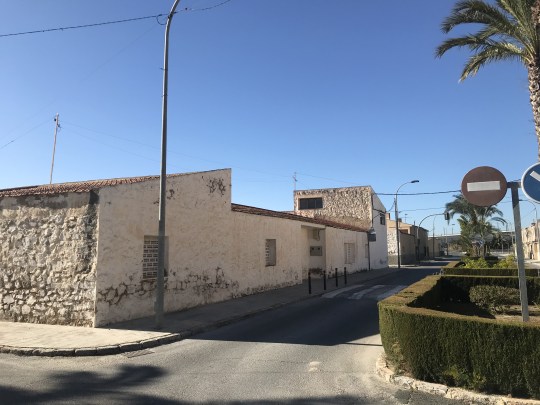
Street profile in San Isidro. | Photo © Carolina Gomez
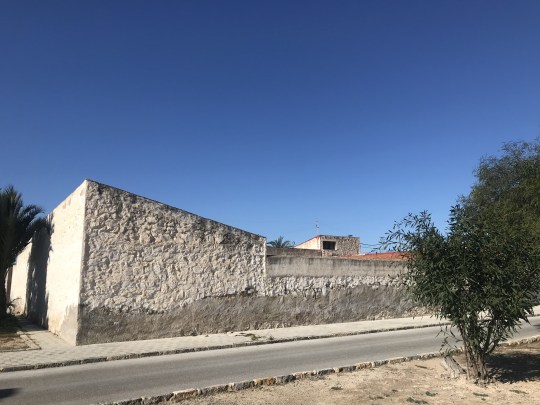
Residential unit and its back courtyard. | Photo © Carolina Gomez
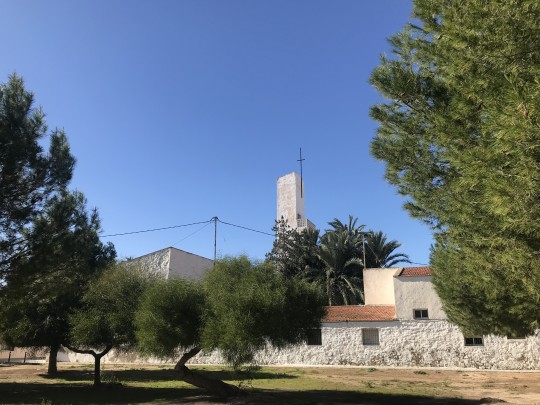
Mix of nature and stone white walls in El Realengo. | Photo © Carolina Gomez
This sedimentary layer is non permeable, so although it rains very seldom (aprox.290,0 mm/year), terrain keeps this water. Combining this particularity with local climate conditions, and its ancient irrigation system, the countryside is very fertile, one of the largest fresh-exporters in Spain.
But lets get back to 1950s in Vega Baja. After the devastation of the Spanish civil war there was the deep need to promote economy, education, and social conditions. National Institute of Rural Development and Colonization was the administrative entity that was established by the Ministry of Agriculture in order to repopulate certain areas of Spain. The Institute acquired land, which it transferred to the villagers under different conditions.
In this scenario Architect Fernandez del Amo, from the institute was developing village planning for Realengo and San Isidro, among others. The objective was to increase agricultural production, meanwhile providing education and housing for workers.

Palm trees field overlays with public buildings. | Photo © Carolina Gomez
Housing units build the plot facade and contain a patio and backyard for planting and farming uses. Following the experimental nature of Fernandez del Amo, each rural development sets main roads and public buildings in the terrain differently. We can find this research also in the way of treating and including landscape and the combination of urban and nature.

The church in El Realengo. | Photo © Carolina Gomez
Making the most of existing resources is the DNA of the place. The architect was working always with local materials and local knowledge, using masonry construction techniques of each area, collaborating with local expertise like cabinet makers, carpenters, mural artists, giving a value to austerity through eliminating superfluous and presenting naked essential architecture, where lines and volumes express abstractly and still follow efficiency and economy.
Urban spaces and the residential complex are all in all, in a good state. Although we miss elements like irrigation system connected with pedestrian paths and other landscape elements, which will allow a complete understanding of the place. Architectural elements as doors, windows, railings, has not always been respected in most of renovation works, that have lead to kitsch solutions.
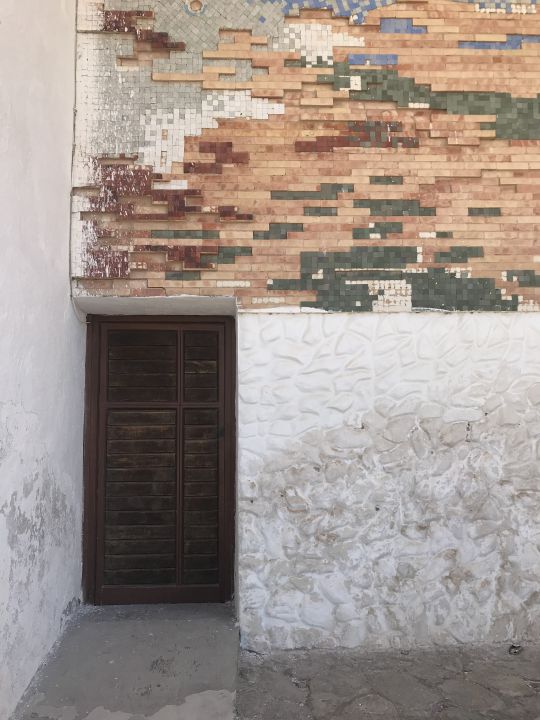
Textures from local masonry, carpentry, mural. | Photo © Carolina Gomez
In an outstanding time, where our way of living and building was evolving, architects like Miguel Fisac, Alejandro De la Sota, Jose Antonio Coderch, and Jose Luis Fernandez del Amo where working with reinterpretation of popular architecture against monumentalism. But how to name it popular architecture, when each step and detail is intellectually extraordinary tailored?
Nowadays, this more authentic postwar architecture concerned with social welfare and austerity connects with climate committed architecture, we are in research. Since 2004, when Rem Koolhaas proclaimed at Columbia University that “preservation is overtaking us”, interest in heritage has grown exponentially. Constructed heritage has expanded to constructed and natural landscapes, infrastructures, and even no-ones lands or in-between spaces. Summing up with climate emergency, we are in the inflexion point where we understand if we are not producing heritage, we are producing waste.

Singular building in San Isidoro. | Photo © Carolina Gomez
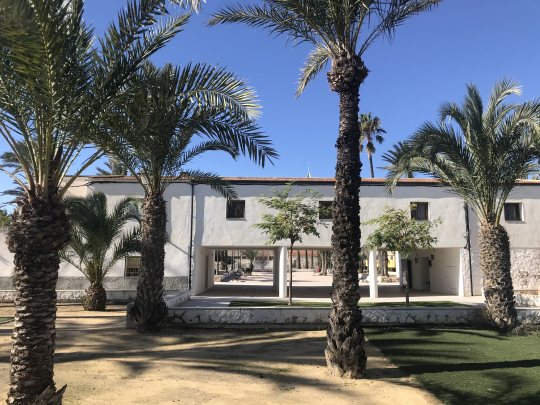
San Isidro main square. | Photo © Carolina Gomez
Lets move to the 60`s in Vega Baja. People were looking for the first time at the coastal line as an attractive place to live in and as a productive landscape (before luxury housing were build in inner fertile areas hiding from the wind and salty atmosphere). Franco's dictatorship exploited sun and beach tourism in Spain through the declaration of National Tourist Interest Areas and Spain was characterized by economic growth.

Dehesa de Campoamor combines different typologies and mix with the existing nature. | Photo © Carolina Gomez
Dehesa de Campoamor was planned as a National Tourist Interest Area by Antonio Orts. It is placed in a singular coastal reddish slope in a landscape of Monte Bajo and Pinada. The project addresses the new demand for summer leisure, experimenting to join functionalist urban planning of the modern movement with the existing nature of the area.
The masterplan research mix of situations: different densities, horizontal and vertical residential typologies and morphologies, radio centric city and garden city, ending up in a rich solution. Masterplan preserves higher environmental quality thanks to the balance between the average density of building and respect for the natural landscape. Lively hood is assured by zoning its main uses and public buildings, especially those related to tourism: yacht club, hotels, restaurants, disco and cinema. We find interesting singular elements as the modern-historical center, the summer cinema, or the yacht Club. Because of all that Dehesa de Campoamor is listed in Docomomo-Ibérico.
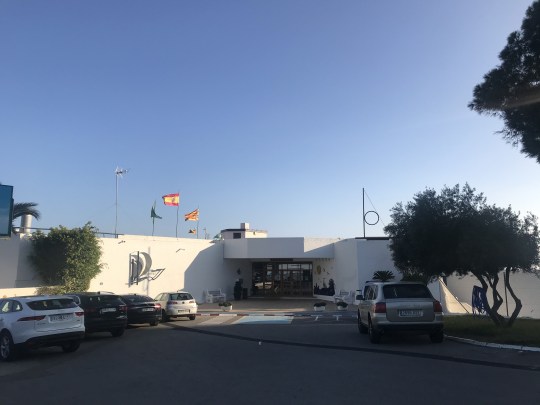
Entrance to Dehesa de Campoamor Yacht Club. | Photo © Carolina Gomez
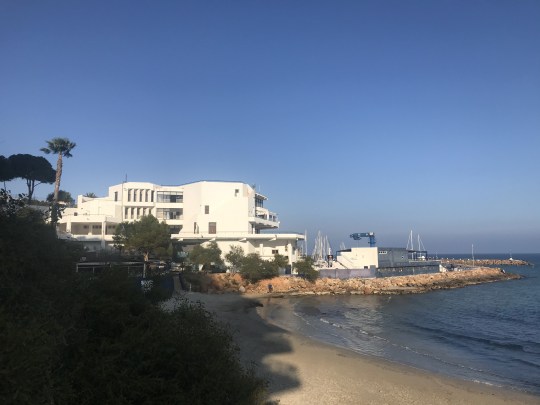
Dehesa de Campoamor Yacht Club from the beach. | Photo © Carolina Gomez
The Yacht Club was developed by Fernández del Amo. The building organises in the steep coastal line based in a hexagonal structure. The architect was familiar working with this shape as he was leading Spanish Brussels Pavillion renovation works with architects Corrales and Vazquez Molezún. The project extract the roots of the popular, attracts and hold the interest in figurative poetics. The building is in a good state and keeps it former uses structure.
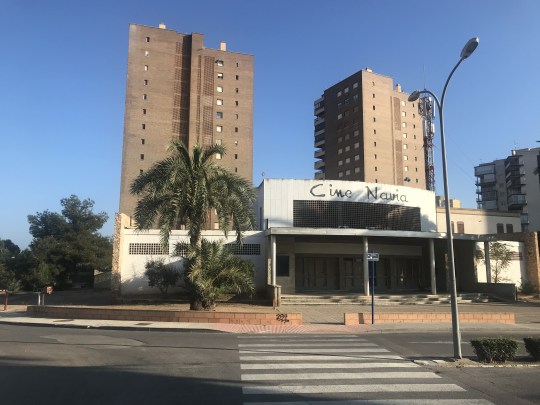
Navia Cinema in Dehesa de Campoamor. | Photo © Carolina Gomez
At the moment of writing this, Countryside, The Future exhibit by Rem Koolhaas and Samir Bantal opens at the Solomon R. Guggenheim Museum in New York. The project presents investigations about the 98% of the earth that is not occupied by cities. Leisure, large scale planning, climate change, migration, ecosystems, preservation. Its time for architects as enablers of the future, to expand their field of vision to countryside, landscape and intermediate spaces.
---
#FOMA 34: Carolina Gómez

Carolina Gómez is an experienced research based strategic urban planner and all-round designer, focusing on landscape, heritage and climate responsive sustainable solutions. Educated as an architect, Carolina has worked independently in urban and landscape design projects of varying scales through Russia, Egypt, and Europe, spanning the fields of analysis, temporary projects, concept visionary design and city transformation projects.
In 2018 she founded Carolina Gómez | Architecture & Environmental Planning in Vega Baja-Spain, where she combines local knowledge with her international experience and strives to build meaningful, context-specific spaces for active and healthy lifestyles, social interaction, sustainable living and exponential technologies.
3 notes
·
View notes
Text
Baby Formula Shortage Highlights Racial Disparities | Maryland News
Baby Formula Shortage Highlights Racial Disparities | Maryland News
By JACQUELYN MARTIN, ADRIANA GOMEZ LICON and TERRY TANG, Associated Press
COLUMBIA, Md. (AP) — Capri Isidoro broke down in tears sitting on a chair at the office of a lactation consultant.
The mother of two had been struggling to breastfeed her 1-month-old daughter ever since she was born, when the hospital gave the baby formula first without consulting her on her desire to breastfeed.
Now,…

View On WordPress
#Associated Press#baby#business#Business News#Collections: Business#Collections: Health#Collections: Political#Collections: Top News#Collections: US#Coronavirus#Delaware#Delaware News#disparities#Florida#Florida News#Formula#Health#Highlights#Hispanics#infectious diseases#lung disease#Maryland#Maryland News#Michigan#Michigan News#News#poverty#product safety#racial#shortage
1 note
·
View note
Photo

escultura de poeta estatua busto Isidoro Manuel Pires en jardin do Coreto parque publico Tavira Algarve Portugal from Rafael Gomez - http://micamara.es https://ift.tt/3a9ypGL
0 notes
Text
NUEVA ESPAÑA: 🇲🇽🇵🇭 Filipinas de Hispana Mexico! Viva! Mabuhay!
undefined
youtube
PRESENT day Mexico & The Philippines are basically similar countries separated by a vast ocean. Both spent 400 years together as sister nations in a shared colonial legacy. Almost over a combined total of 850 years these nations became forcibly invaded and under Spanish colonial rule. You think similar last names and world class champion boxers is all Filipinos and Mexicans share in common?
Filipinos have forgotten that they were administered by the Vice-Royalty of New Spain, present-day Mexico. In Mexico’s view, the Captain General in Manila actually reported to the Viceroy in Mexico City, not to Spain. Hence, the Manila colony was a dependency of the Vice-Royalty of New Spain. This arrangement was to stand until Mexico declared its independence from Spain in 1815.
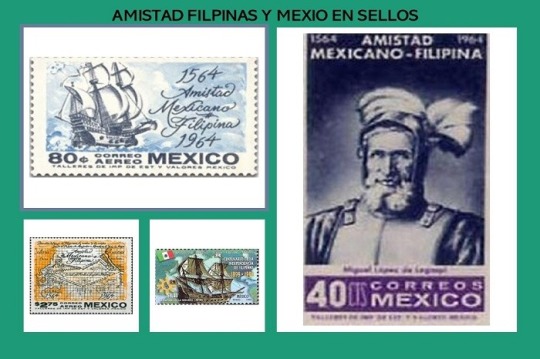
Filipino influence on Mexican culture and vice versa is very apparent. Especially, on Mexico’s Pacific coast, where people today continue to imbibe tuba, a drink derived from the coconut tree. Filipinos revolutionary contribution to the Mexican Revolution, Independence and Mexican traditions is highly ignored by most historians but like this video says you can’t deny history. As our contributions is invaluable.
How did Mexico & the Philippines romantic international relationship begin?
undefined
youtube
DE MANILA-ACAPULCO GALLEON TRADE (1565-1815)
In the late 17th century to the 18th century, the Manila-Acapulco was a galleon trade that extensively began as Europe’s largest important and historical cash crop investment deal and the very first stage of modern Globalisation. Every year the galleon connected the Mollucas (Malaysia, India, Burma, Philippines, Siam, Indonesia etc) to Europe and the New World (Hispaniola & The America’s) via her connection with the Spice Route that continued to supply riches, spices and prized luxury items that gave immense untold fortune and wealth to fuedal Europe and the greater West for over 250 years.
Over two hundred centuries, about a hundred galleons were built in the Philippines. Most of them built by expert craftsmen the Spanish knew as Cagayans in the provinces of Pangasinan, Albay, Mindoro, Marinduque and Iloilo. Actually, due to our strong maritime culture. The Spanish galleon ships were influenced by the sleek and swift design of the Visayan Karakoa, (the archetype modeled boats our Polynesian cousins voyaged on - and a identical upsized version of the outriggers in Disney’s “Moana”.) These karakoa, or proa or “balangai” ships could travel 5 x’s faster than anything European at the time. Intimidating and more durable too.
FACT: One of every five members of these galleons fleet were Filipino natives…it went as high as 50 to 80 percent Filipinos annually. The other crew members were Spanish insulates, Mexican mestizos/creoles like the Salcedos and Aztec Indios and Portuguese.
With so many Mexicans sent to the Philippines within a period of 250 years, it is not surprising then that Mexican language, culture and norms have become integral part of the Philippine consciousness, and this dispersal of mixed native interbreeding explains why some Mexicans and Filipinos look-alike.
LAS PIÑAS & MĒXIHCO
Mexico, for their part, with the Manila-Acapulco Galleons believed that they were directly trading with China. Many Mexicans today think that the galleons sailed directly to Chinese ports. This wrong perception is even reflected in the official marker in Fort San Diego in Acapulco commemorating the La Nao de China. The marker wrongly depicts the galleons as directly sailing to China, not to the Philippines.
What is clear is that the Philippine Colony would not have survived through the centuries without the assistance of Mexico. When Miguel Lopez de Legazpi sailed from Mexico in 1564 to settle the Philippines, he found the living conditions there very difficult.
The farm animals and horses brought from Mexico did not acclimate well with the tropical heat. Legazpi’s soldiers and sailors had to scrounge food from one island to survive. Chroniclers described living in the Philippines as “cuatro meses de polvo, cuatro meses de lodo, y cuatro meses de todo.” (Translation: Four months of dust, four months of mud, and four months of everything). Todo, in this instance, refers to anything that killed the White Man, including tropical diseases, typhoons, volcanoes, and earthquakes.
Legazpi’s luck turned when he stumbled upon Cebu. This is the same island where Ferdinand Magellan met his fate in 1521. There he learned of the existence of a large Muslim settlement in nearby Luzon called Amanillah. (Or Maynilad, depending on which book one choses to believe). He sent Juan de Salcedo and Martin de Goiti to reconnoiter the Malay community for interpreters and translators. See: ( “Enrique de Mallacca” ).
FACT: Despite, Western-Eurocentric histories inaccurate account of truths proclaiming Europeans as the first to circumnavigate the globe. Enrique de Malacca or Henry The Black, was a dark-skinned ‘Malayan’ (rumoured to be a Cebuano) who in fact, contrary to belief had become the worlds very first circumnavigator of the globe.

Salcedo and de Goiti found Chinese traders (and sea pirates) in Amanillah (or Maynilad). This discovery became the key for the survival of the nascent Spanish colony. The discovery of the Chinese traders, the subsequent discovery of the tornavuelta or the return route to Mexico by Fray Andres de Urdaneta, and the establishment of the Spanish settlement in Manila became the foundation of the Manila-Acapulco Galleon trade that was to last for 250 years.
More on the Galleon trade...
The Manila-Acapulco Galleon Trade made Manila an entrepôt of commerce between the Far East and the New World. The galleons embarked from ‘Manila’ which had been a trade hub capital for ancient Chinese, Japanese, Persians, Arabs, Indians etc for nearly 900 years. Ships were loaded with spices, silk, gold, damask, Chinese porcelains, pearls, plants, cotton, indigo, jade, ivory, incense and lacquer ware. These were paid for in Mexican silver coins which became the dominant currency in the Far East. In return, the galleons brought from Mexico the “real situado” (royal subsidy). These were minted silver coins from the mines of Zacatecas in Mexico and Potosi (present-day Bolivia).
It is important to note that without the real situado, the Spanish colony in Manila would not have survived. The Spaniards did not make the new colony self-sustainable. There was never enough Spaniards in Manila to enable a total conquest of the rest of the archipelago. The Spaniards in Manila were more of adventurers, rather than able settlers. They set off to other parts of Asia to look for treasures and adventures. The demand of labor in Manila was so acute that Spanish authorities even had to import black slaves.
The ingenious solution to the manpower shortage problem was, of course, to source them from the New World. Mexico is merely a four or five month-sail by ship. In comparison, sailing to Spain via the Cape of Good Hope took one year. Hence, the vast majority of colonial administrators, missionaries, and soldiers deployed to the Philippines were Mexico-born Spanish, Mexican creoles and indigenous Mexican Indians.
FILIPINOS FOUGHT IN MEXICOS REVOLUTION FOR INDEPENDENCE AGAINST SPAIN
The role played by Filipinos or strictly speaking, Filipino-Mexicans in Mexico’s struggle for independence were very visible.
Mexico’s fight for independence from Spain was started by a priest, Fr. Miguel Hidalgo In Dolores in 1810. Morelos picked up the fight in Western Mexico and personally recruited about 200 native Filipino-Mexicans to join his army. The Filipinos were under the command of legendary general Vincente Guerrero, who later became the first black president of Mexico.

(Above) Vincente Guerrero a Afro-Amerindian mestizo (with possible Filipino ancestry).
Viva La Independencia!
Two Filipinos who fought loyal by his side we’re indentified by historian Ric Pinzon as Francisco Mongoy and Isidoro de Oca. In Mexico they distinguished themselves in battle against Castile-Iberian (Spanish-Portuguese) government troops and are celebrated in the state of Guerrero, Mexico and regarded as legendary folk heroes.
De Oca and Mongoy became brigade commanders in the army of General Jose Maria Morelos in today’s state of Guerrero in the Pacific coast of Mexico from 1810 to 1821. In fact, when Guerrero finally surrendered in 1829, he was accompanied by two Filipino soldiers acting as his right hand compadres. It was Filipino revolutionary; Miguel de la Cruz and a certain black Filipino Aeta indigenous-native (who had no name) but Guerrero had freed from the compulsory system of indentured slavery called “Polo y servicio ” that saw “Filipinos” burdened under a form of enslavement. “Filipino” males aged 16-60 were required to work 40 days a year for the government.
Pinzon also says three former Mexican governors of Guerrero, where present day, Alcapulco is located, had Filipino ancestry. Juan Alvarez, born in Espinalillo, a former Filipino colony in Mexico, actually had Filipino native ancestry and went to become president of Mexico in the late 1800s. A Filipino revolutionary ‘Alejandro Gomez Manganda” whom been heavily involved in the 1910 Revolution became governor of Guerrero, Mexico in the 1940s.
Colonial Caste System
Reminding the reader the term “Filipinos” at the point of reference highlights the cultural hegemony taken place after the Spanish colonial days of ‘Nueva Espana’ (Mexico-Philippines). Saying “Filipinos” in this context reduces the history and people of the 7,108 Islands former pre-colonial kingdom civilisation since its adjectivley improper due to the fact there were NO ‘Filipinos’ recorded at the time. The term ‘Filipinos’ just got used in speaking lexicon to describe the inhabitants of the archipelago in the late 19th century.
At first it was used by themselves.
“Filipinos’ first began as a title refering to the elite Spanish (“insulares”) who were born in “Las Islas de Filipinas” as it was earlier called. This status got afforded also to mixed “Insulares” creole/mestizos with pure Iberian blood whose father and mother were known in the Spanish colonial caste system as (“principales”) a.k.a (“Peninsulares”).
Peninsulares were corrupt, beauracrats and plundering thieves responsible for introducing the land distribution system called “encomiendas”. Interestingly, the said subsidy, a “real situado” usually amounting to 250,000 Mexican pesos, did not come from the Royal Treasury based in Mexico City but consisted of custom taxes imposed on products brought by the galleons in Acapulco. After these were collected, the subsidies were sent to Manila by the returning galleon. Therefore, the Spanish viceroyalty was not preoccupied by appropriating funds for the Philippines, because Mexican buyers were indirectly paying for the financial support of the said colony.
In addition, the value of the “Real Situado” was not standard; although it was fixed at 140,000 pesos in 1700, the actual amount depended on the needs of the moment.
The most known Peninsulare was Miguel Lopez de Legazpi who colonized most of Northern and central Philippines. The black ebony Austroasiatic indigenous “negritos” (Spanish for ‘Short Blacks”) and the Malay-Polynesian brown skinned natives were derogatorily termed “Indios” by the elite. The official establishment of a nearly made Philippine republic and the constitutional “Filipino” citizen had been decided in the honour of royal crown King Philip II of Spain after there was a time for an anglicisation period of the namesake.
Philippines literally translates to “Isles of King Philip”.

Filipino nationalism grew originally along the:
(“Illustrados”) they often were church clergy, scholars, governors who wealthy enough to become acedemic, were idealists, free thinkers, artists, usually a member of Freemasonry and born into the upper-middle class. But, some are not born wealthy like revolutionary Apolinario Mabini who grew up in a family of farmers. Due to shifting economic powers changing these insulares often moved to capitalist driven entrepreneurs owning large parcels of lands called “haciendas”. They could be mixed or born of (“principales”) and (“creoles”) decent. Or both. There were a few main types of Creoles/mestizos.
Types of Mixed Mestizos
undefined
youtube
Mestizo means somebody who is a hybrid of mixed heritage. Normally, associated in Latin America and the Philippines with children of racial inter-marriage.
Mestizo de Espanol - was a person of mixed Filipino and Spanish heritage.
Tornatrãs - was a old Spanish term for mestizos mixed with definite Spanish, Chinese and native Filipino heritage. Nearly every popular Philippine hero was one. Every Filipino today can claim this.
Mestizo de Sangley - was a mestizo not necessarily indexed or are coming from Europeans. A person of de Sangley background was a Filipino or any racial descent who married a Chinese.
The mestizo race fare better than the natives due to the fact that their ancestry provides leverage and connections, which becomes a big advantage in a feudal and colonial society. They may have better relations with the local governors or with the church as they are favored more compared to the common man. Parents of mestizos may have been an alcalde or another important position in the goverment or perhaps an insulare wishing to expand power and territory. In the case of expanding territory, this has been a major motive for most of the arranged marriages that came about during the era.
Secularization was a big deal during his time as Missionary priests (Dominicans, Jesuits, Augustinians, etc.) protested to being supervised by Bishops in running parishes, stating they’re not under a Bishop’s jurisdiction. True enough, because Missionary priests spread Christianity. So the Church started training secular priests to manage parishes for the Bishops. Padre Pelaez sided with the seculars which earned him the disdain of many powerful priests. Unfortunately, he died in an earthquake that struck Manila and destroyed the Manila Cathedral in 1863.
CHINO FILIPINAS
Fact: The earliest recorded Chinese settler communities first in Mexico were not Chinese. The ‘Chinos’ as referred to by Mexican Natives (for looking like people from China) were indeed not Chinese. ‘Chinos’ as they were recognised were common men from the Philippines.
Early Chinese settlers, aka Mestizo De Sangleys in the Philippines were artisans and petty traders but their children with Filipinos were granted special rights and privileges under the Spanish Crown. Eventually, the mestizo de sangley were allowed to lease lands from friar estates and earned from it. Later on, they came to own many lands by benefiting from ‘pacto de retro’ which states if a farmer can’t pay the money they borrowed, the land is kept by the money lender. A huge number of farmers lost their lands this way and the money lenders’ lands kept growing and growing. People nowadays call this “investment.”
The special rights and privileges awarded to mestizo de Sangleys is also the reason why you often get a lot of ‘Chinito’ looking Filipinos abroad today. Most descendant of Chinese-Filipinos families could afford to move abroad.
De Sangleys were often instantly hired by the Spaniards to overseelabour and infrastructure in the colonial society of Las Pinãs. Unlike the natives the were less likely to revolt, and their skin passed for white therefore favoured a lot more. Native Filipino “Indios” resented working for Spanish-Castiles. Often, working meant little next to no daily wage, no food, rough supervised treatment from the law and worse. These native “Filipinos” worked like slaves on plantations/farm land belonging to their original custode and of their own ancestral domain.
Spanish insulare families and families with Mestizo de Sangley heritage exist today as the majority of the Philippines ruling elite. It’s a fact Chinese-Filipinos own more than 85% of the Philippines politics, media, stock market and business franchises.
Really, its not a sufferable caste system like India’s. Its more of classification for valid reasons, but yeah, any grouping or classification brought about brings discrimination. And we, the modern Pinoys, had inherited that colonial thinking of having a foreign ancestry is something to brag about. Get real. Almost everyone here has a bit of foreign in our blood.
NATIONALISM: ‘FILIPINO’ is adjectively improper.
Only in the 1890’s with reluctance and recent activities done by working class revolutionary nationalist heroes such as Andres Bonifacio were the lower class “Indios” included in the Nationalist movement, and by the time of the Katipuneros insurrection of 1898 that triggered thirteen sporadic years of jungle warfare against Americanos in the (Philippine-American War) which became the exact point in time the term ‘Filipino’ applied to every inhabitant of the islands. Even the unconquerable Muslim Moros fighting for sovereignty in the Southern most islands till this present day had temporarily agreed.
Manifest Destiny
The term “Filipino” would have become current in English through the Americans, who betrayed the Filipino revolution of 1898 and established their own colonial rule, under the grand delusion of ‘Manifest Destiny’.
‘Manifest Destiny’ was basically a conceptual idea based around racism and white superiority. Apparently seen in a premonition from the U.S President Arthur McKinnleys eyes himself when God appeared to him in a dream, the entity bestowed upon him a right from the Almighty High to tame, cleanse, civilise and subjugate the native and indigenous “Indios” of The Philippines. They did however co-opt the ‘Filipino’ elite into the colonial system, unlike the Spaniards. Promoting it through a policy of imperial U.S public school indoctrination and ‘Filipinization’.
undefined
youtube
Native ‘Luzones Indios’
Filipino native sailors on the Manila-Alcapulco galleons (1565-1815) remembered as “Nao de China” or “Nao de Acapulco” by some has been estimated at about the 200,000’s range. This 200,00 range of native Filipinos travelling to Mexico since 1565 has obviously through generations doubled, and lead to a significantly dense population of Mexicans currently living in Mexico with Filipino ancestry. Although, it is not one hundred percent sure about how definitive evidence and statistics could be as to who are decent originally from the ‘Luzones Indios’.
Most of the Filipinos on board were known as ‘Indios’ natives like the Native Mexicans and Americans (due to ‘phenotypical’ resemblances in the physical and cultural similarities). They were brought to Mexico on these fleets as mostly indentured slaves, civil servicemen and soldiers.
Filipino Indios namely the ‘Luzones Indios’ made up mostly of Aeta/Ati negrillos/ native Kapampangas/Pintados/ & Eskaya tribesmen etc were responsible for helping the Spanish empire explore and “discover” today’s U.S locations from Louisiana to a large proportion of the West Coast regional area of modern ‘America’ such as California.

A lot of these “Filipino” “Indios” inter-married with many local girls and settled as naturalised citizens of the nation country of Mexico. They happened also to be mercantile soldiers who fought under Spain and became valued by the Iberian-Castile (Spanish/Portuguese) government for their extensive sea faring knowledge and navigation skills in and around the Pacific Ocean & Asia to the continent of the Americas.
Filipinos First in The Americas?
The first ever recorded ‘Filipinos’, perhaps in fact the first migrants of ‘Asians’ ever on the American continent has to chronologically be categorised by record accounts.
Is it the ‘Pensionados’? An elite scholarly class of ‘Filipinos’ invited by the U.S government to study in 1906, in American universities in places like Hawaii and Washington during America’s occupation of the Philippines? Was it the ‘Maynila Men’ of New Orleans? The Filipino men who joined with ‘Americans’ and helped make what would later become the United States of America fight arduously against the British Invasion during the battle of New Orleans, and allied joint forces with them in the war of 1812. Also, making Louisana their home as early as the 1760′s? Or, was the first Filipinos on the continent? the native sailors of Pampangca? the ‘Luzones Indios”?
Filipino natives from ‘Las Islas Filipinas’ whom respectfully helped the Franciscan Friars found and establish the first earliest cities and towns that is now California.
Did you know? The province of Texas at the time of Domingo Ramóns 1716 expedition located on the borders of Mexico, Louisiana & Missouri Territory primarily was given the secondary name ‘Nuevo Reino de Filipina’ but more infamously, Texas was known officially throughout the entire colonial period as ‘Nueva Filipinas’ (New Philippines).
If you tried and made guesses to any of the ‘Filipino’s above however? they would all technically be incorrect.
The first Filipinos who ‘settled’ in the New World society of the Americas (with understanding the South-West part of present day United States was once the country Mexico.) Were leaders of ‘Conspiracy of 1588-89′. Four, royal rebel deviants insanely pissed at the Spanish colonizers for stealing their native land and changing the order and way of life. They were the four followers of Magat Salamat, the son of Rajah Lakandula who was the chieftain of Tondo, Maynillad (Manila) at the time.
Gabriel Tuambacan, Francisco Aeta, Luis and his son Calao (whose families name we’re not recorded) became the first “Pinoys” (Filipinos) to be exiled to the state of Mexico by Governor Santiago de Vera in 1588 after their first abortive revolt against Spain.
Their exile destination was Acapulco, Mexico but they first landed reportedly at Baja, California, 1588.

‘The Magat Salamat’ - ‘Conspiracy of 1588-89′
Why were Magat Salamats followers exiled?
Historically speaking, this plot or “conspiracy of 1588-89” is important. It was the first concerted attempt of the Filipino to oust the Spaniards and gain their freedom with the help of a foreigner, the Japanese. Also, with the Sultan of Borneo’s help to aid the conspirators.
The only extant original document that throws light upon this ‘revolt’ is from the actual written ‘report’ of Estaban de Marquina, notary public of Manila, to Santiago de Vera, Governor General of the Philippine islands (Reprinted in Blair and Robertson, “The Philippine Islands,” Vol 7, pp 95 ff.).
Unfortunately, historiography records that documented these perambulate and turbulent times of ancient pre-colonial Rajas (Kings) & Datus (Chiefs) that ruled over the Islands before the Spanish conquerers invaded, had lead the first native resistive fight against the Spanish Conquistadores. It has always been written in the unimaginative galls of the debunking school of historians, and some even dismiss the “Conspiracy of 1588-89″ with the bare few sentences actually written and described from the likes of Augustinian historian Martinez de Zuñiga, in his “Historia de Philipinas,” and the oidor-historian, Antonio de Morga, in his “Sucesos de las Islas Filipinas,”. This clearly may have been due to a lack of sources or frankly to the fact that they looked upon the matter from the prejudiced Spanish point of view. Sadly, there is barely a documentary source to represent the Filipino side of the subject.

(Above) El Galleon Dia Manila-Acapulco (Cartographic routes)
LEARN MORE about the plot, the conspiracy, and the failed revolt that arguably initiated the Island nations first semblance of their revolutionary forces ‘The Katipunan’ against the oppressive Spanish colonial empire. 300 years before the ‘KkK’ was founded by Dr. Jose Rizal, Andres Bonifacio, Emilio Aguinaldo etc.
REVOLUTIONARY FILIPINOS EXILED TO MEXICO. VICE VERSA, NATIVE-MEXICAN REVOLUTIONARIES EXILED TO THE PHILIPPINES.
With the Spanish colonial occupation of the Philippines. Native blooded Filipinos, and indigenous, “Indios”, and individuals from every ranks of the caste system, often got punished by execution, if not. Exported for exile to places like (Ladrones Islands) Guam and Mexico. Through the years, the Spanish used mainly both New Spain (Mexico) and Manila as the dumping grounds for what Spanish authorities considered ‘subversives’ or luminary ‘deportees.
Find out more: https://notesfromalonghotsummer.com/subversives-and-deportees/
Nueva Espana was the cultural interchange between the two colonies (Philippines & Mexico). What Filipinos today regard as a Spanish influence in food, language, and customs may in fact be Mexican in origin.
We have acculturated and adopted so many things from Mexicans in Filipino culture. Besides the monetary standard the Peso, and celebrated holidays in both countries such as “Dia de los Muertos” (day of the dead). This day is known as “Todos Los Santos” in the Philippines. Mexicans and Filipinos alike troops to the Campo Santo. Strangely, this is the same term used by Filipinos and Mexicans to describe a cemetery. For two days, they bring food, flowers and candles to their departed ancestors.
Systema Kultura
There are many social and cultural elemental exchanges that occurred, you probably didn’t know about. For example:
Religion
1. Christian Catholicism religiosity amongst Filipino and Mexican folk perhaps is the most obvious display of Spain’s lasting hispanicized influence on the hundred native indigenous cultures they genocided, and raped to near extinction. It personally feels like it slaps and confuses the intelligence of the ancestors who fought for their very ancestral homes away from invaders to strictly follow the invading colonizers religion. Despite this, acts of holy devotion towards the “Santo Ninõ” (baby Jesus) and the veneration of “Our lady the virgin of Guadalupe” is a shared custom between Mexicans and Filipinos only.
Millions of Mexicans troop every year to the Basillica Nuestra Señora de Guadalupe, Patron Saint of Mexico. It turns out that Filipinos have also chosen Our Lady of Guadalupe as the Heavenly Patroness of the Philippines. She is known in the Philippines as the Virgin of Antipolo or, formally, Nuestra Señora de la Paz y Buen Viaje .
Linguistic Exchanges
2. A lot of important often used words in our National Tagalog language actually come from indigenous Mexican/Azteca “Nuahati” root based language. According to Wikipedia over 200 loanwords in Tagalog borrow from “Nuahatil”. Some of these may include: palanque, achuete, atole, balsa, bangueta, cachauete, cacao, caimito, calabaza, camachile, camote, calachuche, chico, tiangui, tocayo, zacate, Zapote…and guess what? Our very words for Mother and Father in Filipino Nana[y] and Tata[y] are of indigenous Nuahtil Mexican/Aztec origins.
Traditional Songs, Plays & Dances
3. Although modern Filipinos are not aware of it, a number of traditional Filipino dances and musical compositions of ours originated from Mexico not Spain! The “la paloma”, “Sanduga Mia”, “Jarabe” and “Pandango de Sambalillo” for example we’re composed and first heard in the New World. The traditional National attire for men in Mexico, Philippines and even Cuba are exactly the same. The attire is a shirt originally made from pineapple fibre and is worn by men commonly used in special occasions, and in our dances. It is called to Filipinos “Barong Tagalog”. It is said to have been copied from the “guayabera” aka “Camisa de Yucatan” outfits worn by Mexicanos nd some Cubanos. All three countries claim to have originated the design.
(Our Indio natives from Philippines and the Mayan-Aztec descendant indio natives of Mexico must have worked together the special attire during the colonial days and more likely it was contributed in the provinces (probably in Jalisco or Guerrero in Mexico). Not surprisingly, the highest demographics of Filipino-Mexicans is in Jalisco and Guerrerro.
La China Poblana
Another, significant sign of the cultural impact Las Islas Flipinas had on Mexico is shown in the National attire for Mexican women. The beloved ‘China Poblana’ dress.

The myth surrounding this unique dress made for girls and women all over Mexico (especially in Puebla, Mexico) is around the years 1619 a historical women figure in Mexican history appears out of nowhere. Truth, be told her origins remain quite ambiguous. Legend and oral folklore says she is prominently best remembered to be a so-called princess of ‘Asian’ decent, first sighted wearing a native ‘Filipino’ dress that can easily be identified in the Philippines Boxer codex. Her real name by the way, was “Mirrha”.
According to written biographical accounts about ‘Mirrha’ aka Catarina de San Juan. She claimed a royal lineage that originally supposed goes back to India in a country governed by the ‘great Mughals’. Her maternal grandparents was the rulers of all of India and Arabia. The abduction of her and her brother (perhaps found in the Mollucan pirated seas) had seen them both shipped as slaves to the Manila port in the islands of the Philippines bought by Spanish merchants to be brought upon a Manila-Acapulco galleon vessel on her annual trip to Acapulco, Mexico. She was sold as a slave to Captain. Miguel de Sosa in Puebla, Mexico.
‘Catarina de San Juan’ was her Christianised name. She’s been pleaded by native Mexicans for the church to beatify her soul. She was remembered as a famous religious oracle. Apparently, she got along really well with the local natives and she is known to have had healing powers, psychic abilities and walked with an unrivalled graceful aura about her. ‘Catarina’s’ definable reverence in Mexican society has long made her memory the catalyst image of “womanhood” in Mexico and has inspired the centuries long impact of fashion in Mexico. Including, popular Mexican-Indian womanist icon ‘Frida Kahlo’ who considered ‘Catarina de San Juan’ the symbolised epitome of beauty.
Traditional Foods/ Meals
4. Some of our popular traditional Filipino native food and dishes, and vice versa for the Mexicans; are actually stylised cuisine-by-products of Mexico and Philippines. Actually culinary was perhaps the biggest shared contribution. Having assimilated, inter miscegenated and influenced in people exchange and cultural presences during our 300 year long united colonial legacy and shared centuries as sister nations this was only expected.
In 1618 - 74 of 75 crew members of the galleon “Espiritu Santo” abandoned ship. They were then asked by local native Indians to teach them how to make “tuba”, or sold in the side streets of Mexico as “tuba Fresca”. A inexpensive wine made from coconuts. The Filipino native Indios also imparted their know-how in making ‘cerviche’ (seafood kinilaw) and other unique ways of broiling fish and shrimp.
While it is common knowledge that Mexican mangoes came from the Manila men and their homeland. Does it really come as a surprise the coconut tree, they call Palmera, also originated from the Philippines? The state of Guerrero where Acapulco is located, is Mexico’s biggest producer of coconuts and coconut products. Filipinos introduced a wide range of native flora, and fruits to Native Mexicans like, carambola (star fruit), rambutan, papaya, tamarind, and even sugar bananas that miraculously survived the long trip across the Pacific and thrived in the New World. Mexican natives brought vice versa to Las Islas Filipinas plant-fruits like the Cacao, pineapple, pomegranate, maize, guava and avocado.
undefined
youtube
Food plates in the Philippines such as: Escabeche, Leche Flan, Lechon, Chicharron, Turon, Mango Suman, Empanadas, Tinola, Caldareta, Pan de Sal, Spanish style Tilapia, Laiing, Puchero, Maja Blanca were inspired originally from native Mexicans.
For Mexicanos famous Mexican dishes like: Sopa Azteca, Pollo en mole, Mollettes, Churros, Carne en su jugo, Flautas, tostadas de rajas, tortillas and choco pan de maya, and even famous present cervesaz (beers) in Mexico like Cerveza Negra, Modelo were originally crafted and influenced by intermingled native Filipino and Mexican societies. Tequila, moreso the distilling method of Mezcan, dare, I say was also a consumer good and creation with origins from Filipinos.
What Happened?
Mexican influence and ties to the Philippines was lost indefinitely and cut off before Philippines could achieve successful independence from Spain and gain aid and the promised militant assistance from our Mexican revolutionary brothers and sisters in arms around 1823. From that time on Spain had seized the Manila-Acapulco galleons trade and terminated our nations relations with Mexico due to the growing fears of our combined rebel, insurrectionist revolutionaries joining to conspire and grow bigger with our Americanised Latino counterparts in Mexico.
Despite this however, Mexicans, and Filipinos have always long been allies in community solidarity and unionized strengths within present day society in Central America (United States of America). Even during WWII the first and only international military aid ever offered from Mexico’s military army was when The Aztec Eagles Squad was sent to the aid and assistance of the Philippines troops (could that serve as the promised revolutionary help Vincente Guerrero and other Mexican revolutionaries promised to The Philippines to give back in Nueva Espana days?). Also, especially in the affinity shared between them with the Los Angeles Chicano “gang” (native resistances) culture, West-Coast rap music accomplishments & cultural brown political movements like the La Raza movement and Cesar Chavezs (UFW) United Farm Workers.

UFW was a Civil rights activist group lead by mainly Mexican & Filipinos. They fought in solidarity beside each other, The Black Panthers and the Yellow Perils.
The UFW movement was extremley detriment and important to Filipinos, Mexicans and other identifable Latino groups in the 70s and 80s with their fight against oppressors and in their similar opressed struggle for equality, fair work wages and battles against institutional racism and white cultural supremacy.

NUNCA OLVIDEZ!
#nueva espana#mexico#philippines#spanish colonialism#decolonize#mestizo#mexican revolution#katipunan#manila-acapulco#white mans burden#chicano#la raza#culture#history#zapatistas#united farm workers#black panthers#yellow peril#pre-colonial philippines#native american#moana#indigenous#ferdinand magellan#vincente guerrero#andres novales#andres bonifacio#manifest destiny#indios#aztecs#themoreyouknow
1 note
·
View note
Text
"TEªMO"
— Benjamin Esposito. "El secreto de sus ojos".
#el secreto de sus ojos#ricardo darín#Benjamin Esposito#Soledad Villamil#Irene Menéndez#Guillermo Francella#Pablo Sandoval#Pablo Rago#Ricardo Morales#Javier Godino#Isidoro Gomez#“Usted dijo perpetua”
8 notes
·
View notes
Text
CERRAMOS LAS NOMINACIONES
Acá está la lista completa de latinos sexyman que fueron elegidos por repetición o sea, opinión popular y particularmente porque NO ME HICIERON DOLER LOS OJOS CUANDO LOS LEÍ DIOS SANTO ALGUIEN SUGIRIÓ A JENSEN ACKLES:
Juan Carlos Bodoque y Tulio Triviño (31 Minutos)
Don Ramón, El Chapulín Colorado y el Profesor Girafales (personajes asociados a Chespirito)
Black Hat y Dr Flung (Villanos)
José Carioca y Panchito Pistoles (Los tres Caballeros/Disney)
Reaper/Gabriel Reyes y Lucio (Overwatch)
Bruno (Encanto)
Gomez Addams (Los locos Addams)
Kronk y Pacha(Las locuras del Emperador)
EL CEPILLO COLGATE porque me mandaron 500 mensajes pidiendo que lo ponga
Mr. Trance (Mr. Trance)
Ravenna y Santos (Los Simuladores Argentina)
Manolo y Joaquin (El libro de la vida)
Carlitox (Alejo y Valentina)
Lobo/La muerte (Gato con Botas 2)
Speedy Gonzales (Loony Tunes)
Don Armando (Betty la fea)
Adrián Seidelman y Lucas Amato (Cyber Six)
Hector Rivera (Coco)
Condorito (Comics chilenos)
Isidoro Cañones (Comics argentinos)
Coco (Una película de huevos)
Rodolfo Rivera (El Tigre/Nickelodeon)
Carlos (WTNV)
El Locutor (La Frecuencia Kirlian)
Caesar Salazar (Rex)
Juandisimo (Los padrinos mágicos)
El Mandalorian (Star Wars)
El papá de Mafalda (Mafalda)
331 notes
·
View notes